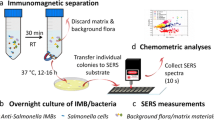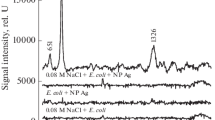Abstract
This research was conducted to prove that developed silver biopolymer nanoparticle substrate for surface enhanced Raman scattering (SERS) technique could detect and differentiate three different serotypes of Salmonella. Nanoparticle was prepared by adding 100 mg of silver nitrate to a 2 % polyvinyl alcohol solution, then adding 1 % trisodium citrate to reduce silver nitrate and produce silver encapsulated biopolymer nanoparticles. Then, nanoparticle was deposited on a stainless steel plate and used as SERS substrate. Fresh cultures of Salmonella typhimurium, Salmonella enteritidis and Salmonella infantis were washed and suspended in 10 mL of sterile deionized water. Approximately 5 μl of the bacterial suspensions were placed on the substrate individually and exposed to 785 nm laser excitation. SERS spectral data were recorded between 400 and 1,800 cm−1. SERS signals were collected from 15 different spots on the substrate for each sample. PCA model was developed to classify Salmonella serotypes. PC1 identified 92 % of the variation between the Salmonella serotypes, and PC2 identified 6 % and in total 98 % between the serotypes. Soft independent modeling of class analogies of validation set gave an average correct classification of 92 %. Comparison of the SERS spectra of Salmonella serotypes indicated that both isolates have similar cell walls and cell membrane structures which were identified by spectral regions between 520 and 1,050 cm−1. However, major differences were detected in cellular genetic material and proteins between 1,200 and 1,700 cm−1. SERS with silver biopolymer nanoparticle substrate could be a promising tool in pathogen detection and it would potentially be used to classify them.











Similar content being viewed by others
References
J. Garbutt Essentials of Food Microbiology. 1st edn. (Arnold International Students Edition, London, 1997)
R. Gorman, C.C. Adley, Characterization of Salmonella enterica serotype typhimurium isolates from human, food and animal sources in the republic of Ireland. J. Clin. Microbiol. 42, 2314–2316 (2004)
G. Zhang, L. Ma, N. Patel, B. Swaminathan, S. Wedel, M.P. Doyle, Isolation of Salmonella typhimurium from outbreak-associated cake mix. J. Food Prot. 70, 997–1001 (2007)
M. Tietjen, D.Y. Fung, Salmonella and food safety. Crit. Rev. Microbiol. 21, 53–83 (1995)
T.M. Cotton, J.M. Kim, G.D. Chumanov, Application of surface enhanced Raman spectroscopy to biological systems. J. Raman Spectrosc. 22, 729–742 (1991)
T.M. Herne, A.M. Ahern, R.L. Garrrell, Surface enhanced Raman spectroscopy of peptides: preferential N-terminal adsorption on colloidal silver. J. Am. Chem. Soc. 113, 846–854 (1991)
A. Campion, P. Kambhampati, Surface-enhanced Raman scattering. Chem. Soc. Rev. 27, 241–250 (1998)
S. Cavalu, S. Cinta-Pinzaru, N. Leopold, W.C. Kieffer, Raman and surface enhanced Raman spectroscopy of 2.2.5.5-tetramethyl-3-pyrrolin-1-yloxy-3-carboxamide labeled proteins: Bovine serum albumin and cytochrome. Biopolym. (Biospectrosc.) 62, 341–348 (2001)
K. Kneipp, H. Kneipp, H. Manoharan, E.B. Hanlon, I. Itzkan, R.R. Desari, M.S. Feld, Detection and identification of single DNA base molecule using surface enhanced Raman scattering (SERS). Phys. Rev. E57, R6281 (1998)
M.K. Weldon, M.D. Morris, Surface enhanced Raman spectroscopy of bulk and microscopic human colon tissue. Appl. Spectrosc. 54, 124–130 (2000)
W.R. Premasiri, D.T. Moir, M.S. Klempner, N. Krieger, G. Jones, L.D. Ziegler, Characterization of the surface enhanced Raman scattering (SERS) of bacteria. J. Phys. Chem. B 109, 312–320 (2005)
A. Sengupta, M. Mirna., E. James Davis, Detection of bacteria by surface enhanced Raman spectroscopy. Anal. Bioanal. Chem. 386, 379–1386 (2006)
G.D. Chumanov, R.G. Efremov, I.R. Nabiev, Surface enhanced Raman spectroscopy of biomolecules. Part I.—Water soluble proteins. Dipeptides and amino acids. J. Raman Spectrosc. 21, 43–48 (1990)
T. Vo-Dinh, K. Houck, D.L. Stokes, Surface enhanced Raman gene probes. Anal. Chem. 66, 3379–3383 (1994)
L. Zeiri, B.V. Bronk, Y. Shabtai, J. Eichler, S. Efrima, Surface-enhanced Raman spectroscopy as a tool for probing specific biochemical components in bacteria. Appl. Spectrosc. 58(1), 33–40 (2004)
L. Zeiri, S. Efrima, Surface-enhanced Raman spectroscopy of bacteria: the effect of excitation wavelength and chemical modification of the colloidal milieu. J. Raman Spectrosc. 36, 667–675 (2005)
R.M. Jarvis, A. Brooker, R. Goodacre, Surface enhanced Raman spectroscopy for bacterial discrimination utilizing a scanning electron microscope with a Raman spectroscopy interface. Anal. Chem. 76, 5198–5202 (2004)
A. Sengupta, L. Laucks Mary, E. James Davis, Surface-enhanced Raman spectroscopy of bacteria and pollen. Appl. Spectrosc. 59(8), 016–1023 (2005)
R.M. Jarvis, R. Goodacre, Discrimination of bacteria using surface enhanced Raman spectroscopy. Anal. Chem. 76, 40–47 (2004)
M. Kahraman Mehmet, Y. Mu¨ge, S. Fikrettin, C. Mustafa, Convective assembly of bacteria for surface-enhanced Raman scattering. Langmuir 24, 894–901 (2008)
E.S. Grabb, R.P. Buck, Surface enhanced Raman spectroscopic investigation of human immunoglobulin G adsorbed on a silver electrode. J. Am. Chem. Soc. 111, 8362–8366 (1989)
T. Wantanabe, H. Maeda, Adsorption controlled redox activity. Surface enhanced Raman investigation of cystine versus cystein on silver electrodes. J. Phys. Chem. 93, 3258–3260 (1989)
C.S. Ki, M.L. Sung, S.P. Tae, S.L. Bum, Preparation of colloidal silver nano particles by chemical reduction method. Korean J. Chem. Eng. 26(1), 153–155 (2009)
G.M. Guzman, D. Jean, G. Stephan, Synthesis of silver nanoparticles by chemical reduction method and their antimicrobial activity. Int. J. Chem. Biol. Eng. 2(3), 104–111 (2009)
Y. Da-Guang, L. Wen-Ching, L. Chien Hong, C. Lin Mei, Y. Ming-Chien, An in situ reduction method for preparing silver/poly (vinyl alcohol) nano composite as surface enhanced Raman Scattering (SERS)-active substrates. Mater. Chem. Phys. 101, 93–98 (2007)
P.C. Lee, D. Meisel, Adsorption and surface enhanced Raman of dyes on silver and gold sols. J. Phys. Chem. 86, 3391 (1982)
W.J. Krzanowski, Principles of Multivariate Analysis: A User’s Perspective (Oxford University Press, Oxford, 1988)
H. Martens, T. Naes, Multi Variate Calibration (Wiley, New York, 1989)
A. Panacek, K. Libor, P. Robert, K. Milan, V. Renata, P. Nadezda, V.K. Sharma, N. Tatjana, Z. Radek, Silver colloid nanoparticles: synthesis, characterization and their antimicrobial activity. J. Phys. Chem. B 110, 16248–16253 (2006)
Acknowledgments
This work has been partially funded by the National Institute for Hometown Security, USA and Animal, Plant and Fisheries Quarantine and Inspection Agency, Korea. The authors are gratefully acknowledging their assistance.
Author information
Authors and Affiliations
Corresponding author
Rights and permissions
About this article
Cite this article
Sundaram, J., Park, B., Hinton, A. et al. Detection and differentiation of Salmonella serotypes using surface enhanced Raman scattering (SERS) technique. Food Measure 7, 1–12 (2013). https://doi.org/10.1007/s11694-012-9133-0
Received:
Accepted:
Published:
Issue Date:
DOI: https://doi.org/10.1007/s11694-012-9133-0




